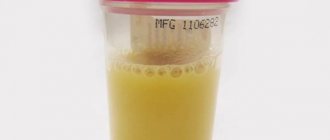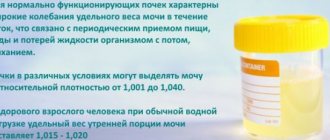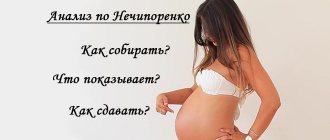Preparation
Special preparation for urine collection for urine analysis according to Zimnitsky is not required.
You must first agree with your doctor about stopping diuretics (diuretics) on the day of urine collection.
The patient should record the amount of all fluids consumed on the day of urine collection (water, tea, coffee, juices, soups, and intravenous drips) and provide this data to their doctor along with the test results.
You must first obtain 8 sterile containers from the laboratory or purchase them at the pharmacy. Also at the pharmacy you need to purchase a container for collecting urine with graduation to determine the volume of each portion of urine.
Urine collection procedure:
Urine is collected throughout the day.
At 6 o'clock in the morning, empty your bladder, pour this portion of urine into the toilet, its volume is not recorded.
Over the next 24 hours, 8 portions of urine are collected every 3 hours (until 6 o'clock the next morning).
- 1st portion - from 06:00 to 09:00
- 2nd portion - from 09:00 to 12:00
- 3rd portion - from 12:00 to 15:00
- 4th serving - from 15:00 to 18:00
- 5th portion - from 18:00 to 21:00
- 6th portion - from 21:00 to 24:00
- 7th portion - from 24:00 to 03:00
- 8th portion - from 03:00 to 06:00
Urine collection is carried out in a dry, clean, graduated container.
After each urination, it is necessary to record the volume of the collected portion (for example, 256 ml).
Then the urine in the container needs to be mixed and some (about 60 ml) poured into one sterile container, the remaining urine should be poured out.
On the container write the volume of the entire portion and the time of collection of this portion.
Close the container tightly with a lid and store in the refrigerator at a temperature of +2...+8°C.
Thus, you need to collect 8 portions of urine per day.
The next morning, deliver all portions to the laboratory.
IMPORTANT! If you did not urinate during a certain period of urine collection (for example, from 15.00 to 18.00 hours), then an empty container must be delivered to the laboratory. On the empty container, indicate the time interval and serving volume - “0 ml”.
There is no need to get up specifically at night to urinate if there is no urge to urinate.
Urine analysis according to Zimnitsky
Urine analysis according to Zimnitsky
— the study is designed to assess the concentration function of the kidneys, i.e. their ability to concentrate and dilute. Urine for analysis is collected within 24 hours. During the test, the daily, day and night amounts of urine and the relative density of urine in each of the 3-hour portions (8 portions in total) are determined.
Normally, in an adult, fluctuations in the volume of urine in individual portions range from 40 to 300 ml. Fluctuations in the relative density of urine between the maximum and minimum values should be at least 0.012–0.016 g/ml. Significant daily fluctuations in relative density are associated with the preserved ability of the kidneys to concentrate and dilute urine depending on the constantly changing needs of the body.
Normal renal concentration function is characterized by the ability to increase the relative density of urine during the day to maximum values (over 1020 g/l). Normal dilution ability is the ability to reduce the relative density of urine below the osmotic concentration of protein-free plasma, equal to 1010–1012 g/ml.
Indications:
- signs of renal failure;
- chronic glomerulonephritis, pyelonephritis;
- hypertonic disease;
- diagnosis of diabetes insipidus.
Preparation After
waking up at 6:00 am, the patient urinates in the toilet. Then you need to record the time of the first urination. After this time, during the day the patient collects exactly 8 portions of urine every 3 hours.
1st serving - from 06:00 to 09:00 2nd serving - from 09:00 to 12:00 3rd serving - from 12:00 to 15:00 4th serving - from 15:00 to 18 :00 5th serving - from 18:00 to 21:00 6th serving - from 21:00 to 24:00 7th serving - from 24:00 to 03:00 8th serving - from 03:00 until 06:00
The volume of each portion is measured and recorded, since not always the entire portion of urine can fit into the container. The urine from each portion is mixed and a small amount is taken from each portion. The liquid can be placed in a separate vacuum tube. If within three hours the subject does not have the urge to urinate, the test tube is left empty. Also, do not deliberately wake the patient at night or during sleep. During urine collection, the usual water and drinking regime and diet are observed. Excessive fluid intake is not allowed. On the day of the study, it is necessary to avoid taking diuretics.
Interpretation of results
The amount of urine excreted per day (daily diuresis) is 1000–2000 ml for men, 1000–1600 ml for women.
Polyuria
- copious urine output (more than 2000 ml per day).
Oliguria
- decrease in the amount of urine excreted per day (less than 400 ml per day).
Anuria
- a sharp decrease (up to 200-300 ml per day or less) or complete cessation of urine output.
When assessing daily diuresis, you should focus on the ratio of fluid consumed and the volume of urine excreted. Normally, approximately 67–75% of the liquid consumed is excreted during the day.
Daily diuresis is 2/3–3/4 of the total amount of daily urine.
Nocturia
- equality or even predominance of night diuresis over daytime. Nocturia is an important indicator of a decrease in renal concentration function, although it can also be caused by other pathological conditions (heart failure, diabetes insipidus, etc.).
In an adult, fluctuations in the volume of urine in individual portions range from 40 to 300 ml.
The relative density of urine between the maximum and minimum values can range from 1005 to 1025.
Hyposthenuria
- a condition when in any portion of urine the density does not exceed 1012–1013.
Isosthenuria
- a condition when the relative density of urine fluctuates within narrow limits during the day (about 1009–1011). A sharp narrowing of the amplitude of daily fluctuations in the relative density of urine at an even lower level (less than 1009) is called hypoisosthenuria (occurs in severe renal failure).
Hypersthenuria
- a condition when there is an increase in the relative density of urine.
Interpretation of the result
At the medical office, you can get personal advice from a doctor from the “Doctor Q” service on interpreting the results of the study during your appointment or by phone.
It must be remembered that interpretation of the results of a urine test according to Zimnitsky should only be carried out by a doctor, since the results of laboratory tests are not the only criterion for making a diagnosis and prescribing appropriate treatment. They should be considered in conjunction with medical history and the results of other possible examinations, including instrumental diagnostic methods.
An adult normally excretes approximately 67–75% of the liquid he drinks during the day. Daytime diuresis should exceed nighttime and amount to 2/3–3/4 of the total amount of daily urine. The relative density during the day ranges from 1.005 to 1.025 g/ml.
If night diuresis predominates over daytime diuresis, then this indicates a decrease in the concentrating ability of the kidneys. Nocturnal predominance of diuresis is often found in diabetes insipidus and heart failure.
An excess of urine density above 1.025 g/ml is observed in cases of dehydration, pyelonephritis, and uric acid diathesis in children.
A decrease in urine density below 1.005 g/ml indicates a decrease in the concentration function of the kidneys and occurs in renal failure, chronic glomerulonephritis and pyelonephritis, diabetes insipidus and diabetes mellitus, hyperaldosteronism, while taking diuretics, severe potassium deficiency, excess calcium,
To confirm the resulting pathological abnormalities, the doctor may prescribe stress tests to the patient to dilute and concentrate urine.
Standard indicators according to Zimnitsky
The following indicators indicate that the patient’s Zimnitsky tests are within normal limits:
- the daytime amount of urine excreted exceeds the nighttime amount;
- during the day, in different portions, the specific gravity of urine fluctuates between 1.004 -1.032, and the difference between the highest and lowest specific gravity should exceed 0.007;
- after drinking liquid, the volume of urine excreted increases;
- the daily volume of urine excreted should be at least 80% of all fluid consumed during this period.
What it is
WARNING!
The information on the site is provided for informational purposes and cannot be used to make a diagnosis or make treatment decisions. A urine analysis according to Zimnitsky during pregnancy is carried out to determine the concentration of substances that dissolve in the urine. Changes depend on the time of day. The study allows you to evaluate kidney function.
The study is carried out with the usual daily routine and diet.
The expectant mother should not drink excessive amounts of water, as this may negatively affect the results. As a result, it will be unreliable.
Preparing for the test
It is necessary to donate urine according to Zimnitsky without changing your eating and water habits. Drinking large amounts of water or salty foods can interfere with test results as well as limiting fluid intake.
A pregnant woman can give urine while in a hospital or on an outpatient basis (collect the material at home and take it for analysis). If possible, it is necessary to stop taking medications that affect the density of blood and urine (diuretics, hormonal agents, etc.). Such discontinuation of medications must be discussed with your doctor.
Why is it carried out?
The main purpose of the Zimnitsky analysis is to determine the concentration of substances that are dissolved in urine. The samples of biological fluid obtained during the day vary in volume, smell and color. The concentration of dissolved substances can be determined by knowing the density of urine: the higher this indicator, the more organic substances are contained in the sample.
The presence of organic compounds, glucose and protein indicate the pathology present in the body. The vast majority, normally, contain nitrogenous compounds in urine.
Urine density is one of the indicators that are examined during analysis. Daily diuresis, as well as the amount of urine excreted day and night, must be taken into account. Changes in the volume of urine that is released over a certain period of time indicate existing problems in the body.
Decoding the results of the Zimnitsky test: norms and pathologies
The ratio of the volume of fluid drunk and excreted per day is calculated, and the amount of daytime and nighttime urine is compared:
- Total amount of urine / volume of fluid drunk * 100%. If the result obtained is less than 65%, then this indicates the presence of edema. If more than 80%, swelling is observed. A value in the range from 65% to 80% is normal.
- Daytime urine volume/nighttime urine volume. Normally, daytime discharge is greater than nighttime discharge. If more urine was collected at night, this indicates obvious problems with the kidneys.
The density of urine in each portion is calculated in the laboratory. The difference between its maximum and minimum value is calculated. Insufficiency of renal function is confirmed if the density in all portions is below 1.012, or if the difference between OPL (max) and OPL (min) is below 0.012.
For example, among 8 urine measurements, the maximum density value is 1.030, and the minimum is 1.009. We calculate: 1.030 – 1.009 = 0.021 – the norm.
When is it prescribed?
The need for analysis is determined by the attending physician. At the same time, it takes into account the woman’s complaints and suspicions of the development of pathologies.
Main indications:
- symptoms of kidney failure;
- toxicosis;
- the presence of pyelonephritis and other kidney diseases;
- hypertension;
- additional diagnostics of diabetes mellitus;
- control the amount of urine produced.
It is important to regularly monitor urine levels - this will help to identify violations in time and prevent complications that are dangerous for mother and baby.
How to properly collect urine for analysis and store it
You need to start collecting urine early in the morning: at 6.00 you need to go and urinate, but the urine produced overnight is not needed. Collection into the container begins at 9.00 and ends at 6.00 the next day.
Urine collection scheme:
- 9.00;
- 12.00;
- 15.00;
- 18.00;
- 21.00;
- 24.00;
- 3.00;
- 6.00.
Each filled jar must be placed in a cold place (refrigerator); freezing cannot be done, as this will distort the results. Containers containing urine must be closed.
If the time has come to collect the material, but there is no urge to urinate, then you should leave the container empty. If you have polyuria, there may be too much urine, so you should use 2 jars at a time. That is, all the urine released in 24 hours must be collected; nothing should be poured out. After all the material has been collected, it is necessary to deliver it, along with the records, to the laboratory for analysis.
How to prepare
This analysis is not complicated or difficult. Also, no special preparation is required. To collect urine you need to prepare:
- sterile containers for collecting liquid 8 pcs.;
- a notepad with a pen to record the amount of liquid consumed;
- Set an alarm to collect urine at night.
The liquid is collected during the day.
The only exception is the following products during this period:
- beets (affects the color of urine);
- carbonated drinks;
- salty foods (retains fluid in the body);
- alcohol (especially contraindicated during pregnancy);
- taking diuretics.
If these recommendations are not followed, the result may be unreliable.
Diagnostic value of Zimnitsky analysis during pregnancy
Preeclampsia is a complication of pregnancy, characterized by profound dysfunction of vital organs and body systems. It ranks 2nd among the causes of maternal mortality during childbirth.
Preeclampsia begins with a disorder of water-salt metabolism and has a staged course:
- Hidden edema (weight gain more than 300 g per week).
- Obvious swelling that starts from the ankles, gradually spreading upward.
- Nephropathy in pregnant women - increased blood pressure, the appearance of protein in the urine.
The Zimnitsky test allows you to evaluate kidney function and detect the presence of hidden edema. The essence of the method is to measure daily diuresis - the ratio of the volume of fluid consumed and excreted, and to determine the density of urine with each urination.
Contraindications
The Zimnitsky analysis cannot have any contraindications. The study is completely safe and is often performed during pregnancy. It does not involve intervention in the body or other similar manipulations.
A woman simply needs to collect urine in special containers every 3 hours. At the same time, the usual daily routine is maintained. The diet and drinking regime remains unchanged.
Rules for collecting biological material
You need to collect urine for analysis according to Zimnitsky in this order:
- On the morning of the collection day (at 6 a.m.), urination is performed as usual into the toilet (this portion is not taken into account);
- Next, each urination must be done in a special container. For this, 8 jars with time markings are prepared. Urine is collected in one jar for 3 hours;
- If there has been no urine in 3 hours, it remains empty;
- If the volume of the container is not enough to collect the entire portion, you need to take an additional one. It is signed according to the time;
- At night, you also need to get up every 3 hours;
- The last portion is collected at 6 am the next day.
Thus, if collected correctly, you should get 8 containers with time intervals of 3 hours.
All collected material is stored in a refrigerator with the lid closed. The next morning, all this is sent to the laboratory.











